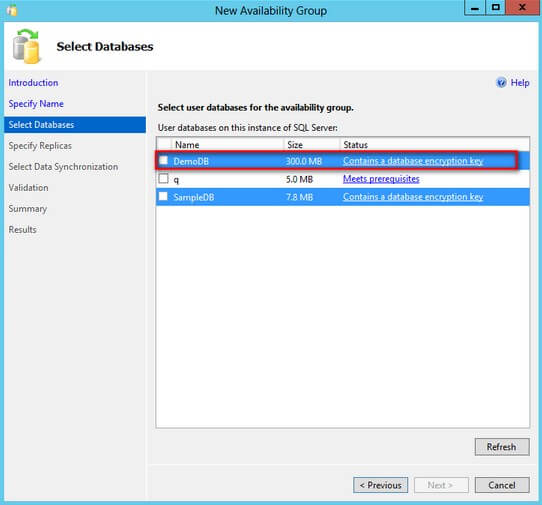

- #DATABASE ENCRYPTION IN SQL SERVER 2012 ENTERPRISE EDITION UPGRADE#
- #DATABASE ENCRYPTION IN SQL SERVER 2012 ENTERPRISE EDITION CODE#
- #DATABASE ENCRYPTION IN SQL SERVER 2012 ENTERPRISE EDITION PASSWORD#
- #DATABASE ENCRYPTION IN SQL SERVER 2012 ENTERPRISE EDITION DOWNLOAD#
Note-: When taking the backup of the tde enabled database and restoring it to the other server instance then not only database will be restored but the certificate with the master key must also be restored on the destination server. –drop the encryption key from tde database is any version starting from SQL Server 2012).
#DATABASE ENCRYPTION IN SQL SERVER 2012 ENTERPRISE EDITION CODE#
The code is given below with the explanation as the comments. Heres the retail pricing for SQL Server 2019: SQL Server Enterprise Edition. Without wasting much of the time I am going to present how we can deal with transparent data encryption in sql server enterprise edition of sql server 2012.
#DATABASE ENCRYPTION IN SQL SERVER 2012 ENTERPRISE EDITION PASSWORD#
Restoring the certificate with the private key.įROM FILE = ‘D:\Nikhil_Documents\TransparentDataEncryption\tdemycertificate’įILE = N’D:\Nikhil_Documents\TransparentDataEncryption\SQLPrivateKeyFile’,ĭECRYPTION BY PASSWORD = encryption off on the required database Only Enterprise edition of Microsoft sql server do have this feature but not others. SELECT DB_Name(database_id) AS ‘Database’, encryption_state –command to enable which database is enabled for tde 3 indicates the encryption state –set the encryption (on) on the required database. TO FILE = ‘D:\Nikhil_Documents\TransparentDataEncryption\tdemycertificate’įILE = ‘D:\Nikhil_Documents\TransparentDataEncryption\SQLPrivateKeyFile’,ĮNCRYPTION BY PASSWORD = the DEK database encryption key with algorithm AES_128 and secured by the certificateĮNCRYPTION BY SERVER CERTIFICATE tdemycertificate (C:\Program Files\Microsoft SQL Server\MSSQL13.MSSQLSERVER\MSSQL\DATA).

The following code stores the backup of the certificate and the private key file in the default data location for this instance of SQL Server Let me start by saying that the instance of SQL Server 2012 I am attempting to set up TDE (Transparent Data Encryption) on, is the Enterprise edition. Create a backup of the server certificate in the master database. Create a database master key and a certificate in the master database.ĬREATE MASTER KEY ENCRYPTION BY PASSWORD = CERTIFICATE tdemycertificate The code is given below with the explanation as the comments. Only Enterprise edition of Microsoft sql server do have this feature but not others.


Hello friends today I got some time and I am going to utilize this time by focusing on Transparent Data Encryption. Transparent data encryption in SQL server 2012 How you manage encryption keys is crucial to your encryption strategy.
#DATABASE ENCRYPTION IN SQL SERVER 2012 ENTERPRISE EDITION UPGRADE#
You do NOT have to upgrade to the Enterprise Edition Encryption Key Management. Recently I had a requirement of implementing a security guideline which stated 'Encryption At Rest'.After much of goggling and reading articles I was able to find a new feature called 'Transparent Database Encryption' in SQL Server 2008.This feature basically allows encryption of database at rest. To take advantage of encryption in Standard Edition you have to upgrade to the 2019 release.
#DATABASE ENCRYPTION IN SQL SERVER 2012 ENTERPRISE EDITION DOWNLOAD#
Sql server training by an Expert ( Developer-Dba)-: Click to know more about this Download TransparentDateEncryption - 21.1 KB Introduction. You may be able to get away with seeing if the storage layer has encryption that can be implemented.Author-:Nikhil Srivastava(Database Adminitrator and Database Dated-: SQL Server 2014 Evaluation, Developer, Enterprise SQL Server 2012 Evaluation, Developer, Enterprise SQL Server 2008R2 Datacenter, Evaluation, Developer, Enterprise SQL Server 2008 Evaluation, Developer, Enterprise Let’s see how we can use TDE (Transparent Data Encryption) in SQL Server Standard Edition. Find out what is required by the business, not managements "everything must be encrypted" and work towards that. But if you have encrypted the data using CLR or the application then you cannot do that and must decrypt every row.Įncryption is hard, don't roll your own. The advantage to using TDE is that SQL understands the encryption and you can search on the encrypted data directly because it is only encrypted on disk. Using the application layer to encrypt/decrypt the data on read and Triggers and CLR functions to do the encryption/decryption for you. I think the confusion is where you are seeing that you can implement column/cell encryption using Enterprise edition OR through alternative methods. You have other options as the articles you reference mention, but they require work on your part to implement. If you have SQL Server Standard edition then you do not have Encryption built into the product.


 0 kommentar(er)
0 kommentar(er)
